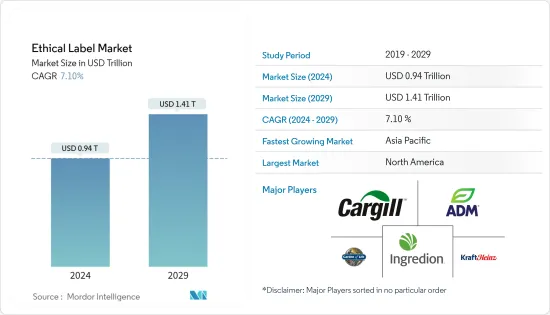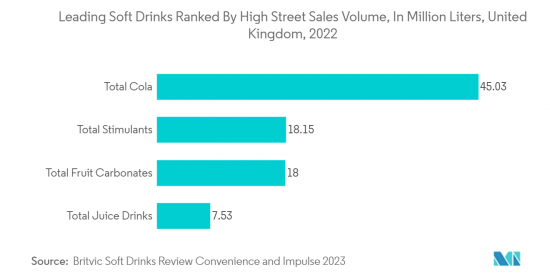 |
市場調査レポート
商品コード
1406167
エシカルラベル:市場シェア分析、産業動向・統計、成長予測、2024年~2029年Ethical Label - Market Share Analysis, Industry Trends & Statistics, Growth Forecasts 2024 - 2029 |
||||||
● お客様のご希望に応じて、既存データの加工や未掲載情報(例:国別セグメント)の追加などの対応が可能です。 詳細はお問い合わせください。
| エシカルラベル:市場シェア分析、産業動向・統計、成長予測、2024年~2029年 |
|
出版日: 2024年01月04日
発行: Mordor Intelligence
ページ情報: 英文 120 Pages
納期: 2~3営業日
|
- 全表示
- 概要
- 目次
エシカルラベル市場規模は2024年に9,400億米ドルと推定され、2029年には1兆4,100億米ドルに達すると予測され、予測期間(2024-2029年)のCAGRは7.10%の見込みです。

正しい食品消費に関する高い意識と関心が、飲食品企業を透明性の確保と自社製品のエシカルラベルの採用に向かわせます。
主なハイライト
- 持続可能な慣行、フェアトレード、倫理的な調達に対する消費者の関心の高まりが、エシカルラベル市場を牽引しています。消費者が個々の食品が環境にどのような影響を与えるかを知りたがる傾向が強まっているため、市場は拡大しています。エシカルラベル市場は、特定の飲食品の受容と消費者の消費習慣の変化により牽引されます。ユダヤ教徒およびイスラム教徒の消費者の貢献は、コーシャおよびハラール倫理認証製品の台頭に起因しています。
- 製造と消費における高い倫理基準の提唱は、環境の持続可能性、動物の福祉、社会正義、平等、より有望な職場と労働者の資質の遵守を促進するエシカルラベルを選択する企業にますます影響を与え、それによって市場を押し上げます。
- 多くの人口、特にミレニアル世代は、健康的でクリーンな認証製品に対する意識を高めるのに大きな影響力を持っています。この動向はベビーブーマー世代にも広がっています。消費者の間では、より栄養価の高い食習慣へと徐々にシフトしています。世界・オーガニック・トレード・ガイドによると、2022年、日本におけるヘルス&ウェルネス(HW)パッケージ食品・飲料の小売販売額は約563億米ドルに達しました。この分野は着実に成長し、2025年には573億米ドルを超えると予測されています。
- しかし、エシカルラベルはしばしば追加的な認証やコンプライアンス対策を必要とするため、メーカーやサプライヤーにとってはコスト増につながりかねないです。これらの追加コストは消費者に転嫁される可能性があり、非倫理的な代替品と比較して倫理的製品は相対的に高価になります。
- 調査対象市場に対するもう一つの抑制要因は、地域や市場によってはエシカルラベルの付いた製品の入手が限られていることです。これは、生産能力の限界、流通の課題、特定の地域における需要の不足など、様々な要因による可能性があります。また、倫理的表示に関する規制やガイドラインを標準化することで、市場に明確性と一貫性を持たせることができます。
エシカルラベルの市場動向
飲料が最も高い市場シェアを占める
- 飲料業界は、アルコール飲料、炭酸飲料、砂糖入り飲料の消費に対する懸念が高まっていることから、堅調な市場シェアを占めると予想されます。
- さらに、飲料業界は、動物の倫理的扱いという評判を維持し、安全性を確保するという課題に直面しています。パッケージ入りココナッツウォーターや非乳飲料のような植物性飲料の出現も、ヴィーガン・ラベル市場の主要な促進要因です。
- キルン&カンパニーによると、健康的な生活は、セルフケアへのホリスティックなアプローチを含むように進化しています。これは、健康的なオーガニック食品を食べ、サプリメントを摂取し、より清潔な製品を使用し、運動し、ストレスを管理することを奨励しています。より環境にやさしく、より衛生的な生活を求めて、消費者は「クリーン」または「ナチュラル」と思われる飲料を選ぶ。グルテンフリー、非遺伝子組み換え、人工着色料・保存料不使用、オーガニック、牧草飼育を謳う製品は、小売店の棚でますます多くのスペースを占めるようになっています。
- 地域別では、アジア太平洋地域の経済成長によって消費者の可処分所得が大幅に増加し、ライフスタイルも変化していることから、アジア太平洋地域が大きな成長機会を提供すると予想されます。これらの要因は、この地域におけるパッケージ飲料の需要に影響を与えると予想されます。中国国家統計局によると、2022年11月、中国では約1,097万トンのノンアルコール飲料が生産されました。
- 紅茶、コーヒー、ココアベース、パック入り飲料水などの従来型飲料が高い普及率を示しています。さらに、ハラール認証や倫理認証を受けた製品がパック入り飲料水に採用され、消費者の支持を集めています。さらに、炭酸飲料など従来の飲料に低カロリー製品を採用することも、クリーンラベルの需要に影響を与えています。
- 清涼飲料水は、こうした飲料の人気と世界の消費の増加により、調査対象市場で大きなシェアを占めています。UNESDAによると、砂糖不使用の低カロリー飲料は現在、多くの欧州市場で売上の30%を占めています。Britvic Soft Drinks Review Convenience and Impulseによると、2022年の英国のコーラ総販売量は4,503万リットルだった。
- さらに、飲料業界のメーカーは、他の競合ブランドと差別化できるほどニッチで、幅広い層の顧客にアピールしたいエシカル・レーベルを選択しています。これが、飲料業界におけるエシカルラベル市場の成長をさらに後押ししています。

アジア太平洋地域は堅調な市場成長率を記録すると予測される
- 消費者の需要の変化と一貫した食品品質へのニーズにより、アジア太平洋地域では高い品質と生産性を維持するための倫理的ラベリングソリューションへのニーズが高まっています。
- アジア太平洋地域における飲料の生産と消費の増加は、調査市場の成長に有利な機会を提供する可能性が高いです。例えば、中国国家統計局によると、2023年1月から2月にかけて、中国では約2,690万トンの清涼飲料水が生産され、前年同期比で0.5%の増加を示しました。また、2022年11月には、中国で約1,100万トンの飲料が生産されました。さらに、2022年8月には、中国で約1,885万トンの清涼飲料が生産されました。
- さらに、中国国家統計局によると、2022年の中国の牛乳生産量は約3,930万トンで、ここ数年で最も多かった。
- 同地域では、多忙な仕事のスケジュール、働く女性の増加、外出先での消費へのシフトにより、包装食品が高い支持を得ており、食品セクター全体で革新的で持続可能なエシカルラベル市場の利用が増加すると予想されます。これは、予測期間中の市場の成長を促進する可能性が高いです。
- カナダ農業・農業食品省によると、中国におけるパッケージ食品の小売売上高は、最近約2,980億1,000万米ドルでした。さらに、包装食品小売売上高は2025年には3,667億米ドルに達すると予想されています。
- さらに、ハラール、オーガニック、クリーン認証など特定のセグメントで多数のベンダーが出現しているため、低価格品と高級品の価格差別化が低下しており、スイッチング・コストは緩やかになっています。予測期間中、特にAPAC地域において、複数の企業が世界的にプレゼンスを拡大すると予想されます。
エシカルラベル産業の概要
エシカルラベル市場は、Archer-Daniels-Midland Company、Cargill Inc.、Garden of Life(Nestle S.A.)などの少数の大手企業によって統合され、支配されています。ベンダーは、製品の品質、清潔で自由なタグ、競争力のある価格設定に基づいて競争しています。持続可能な競争優位性は、デザイン、技術、アプリケーションの革新を通じて得ることができます。市場の主な発展には次のようなものがある:
2023年3月、ingredion社はFibertex CF 502とFibertex CF 102の2種類の柑橘類繊維テクスチャライザーを、機能的でクリーンラベルの原料ソリューションの製品群に導入しました。この動きは、消費者が認識し、慣れ親しんだ原材料を含む食品、健康に有益で自然で新鮮な謳い文句を持つ食品を求める消費者の嗜好の高まりに対応するものです。シトラスベースの新しいテクスチャライザーは、クリーンラベル食品への加速する需要と、栄養、健康、ウェルネスの動向の人気の高まりに対応するための同社の努力の一環です。
2022年3月、DSMはクリーンラベル原料の使用を望む生産者のニーズに応えるため、DelvoGuard培養物を開発しました。このソリューションは、ヨーグルト、チーズ、サワークリームなどの乳製品の保存期間の延長にも役立ちます。
その他の特典
- エクセル形式の市場予測(ME)シート
- 3ヶ月間のアナリスト・サポート
目次
第1章 イントロダクション
- 調査の前提条件と市場定義
- 調査範囲
第2章 調査手法
第3章 エグゼクティブサマリー
第4章 市場洞察
- 市場概要
- 業界の魅力度-ポーターのファイブフォース分析
- 供給企業の交渉力
- 消費者の交渉力
- 新規参入業者の脅威
- 代替品の脅威
- 競争企業間の敵対関係
- 業界バリューチェーン分析
- COVID-19の業界への影響評価
第5章 市場力学
- 市場促進要因
- 健康と倫理観に対する消費者の意識の高まり
- オンライン小売とCSR活動による成長
- 環境維持のための食肉消費削減
- 市場抑制要因
- 競合の増加
第6章 市場セグメンテーション
- ラベルタイプ別
- ハラール
- オーガニック
- クリーン
- サステナビリティとフェアトレードラベル
- 動物福祉ラベル
- ヴィーガンラベル
- その他
- 製品タイプ別
- 食品
- 飲料
- 流通チャネル別
- オフライン
- オンライン
- 地域別
- 北米
- 欧州
- アジア太平洋
- その他の地域
第7章 競合情勢
- 企業プロファイル
- Archer-Daniels-Midland Company
- The Hershey Company
- Cargill Inc
- Go Macro LLC
- Garden of Life(Nestle S.A.)
- Kerry Group PLC
- Koninklijke DSM N.V
- PepsiCo Inc.
- The Kraft Heinz Company
- Ingredion Incorporated
第8章 投資分析
第9章 市場機会と今後の動向

The Ethical Label Market size is estimated at USD 0.94 trillion in 2024, and is expected to reach USD 1.41 trillion by 2029, growing at a CAGR of 7.10% during the forecast period (2024-2029).
A high degree of awareness and concern regarding the right food consumption drives food and beverage companies toward transparency and adopting ethical labels for their products.
Key Highlights
- The increased consumer interest in sustainable practices, fair trade, and ethical sourcing drives the ethical labels market. The market is expanding because consumers are increasingly interested in learning how individual food products affect the environment. The ethical labels market is driven by the acceptance of certain foods & beverages and the shift in consumers' consumption habits. The contribution of Jewish and Muslim consumers can be attributed to the rise of kosher and halal ethical-certified products.
- The advocacy of high ethical standards for manufacturing and consumption increasingly influences companies to opt for ethical labels, which promote environmental sustainability, animal well-being, social justice, equality, and adherence to a more promising workplace and worker qualities, thereby boosting the market.
- A sizeable population, especially millennials, has been influential in increasing awareness toward healthy and clean-certified products. This trend is increasing in the baby boomer population as well. There is a gradual shift among consumers toward more nutritious eating habits. According to the Global Organic Trade Guide, in 2022, the retail sales value of health and wellness (HW) packaged food and beverages in Japan amounted to around USD 56.3 billion. The sector was forecast to grow steadily and exceed USD 57.3 billion in 2025.
- However, ethical labels often require additional certifications and compliance measures, which can lead to increased costs for manufacturers and suppliers. These additional costs may be passed on to the consumers, making ethical products relatively more expensive compared to non-ethical alternatives.
- Another restraint for the studied market is the limited availability of products with ethical labels in some regions or markets. This can be due to various factors like limited production capacity, distribution challenges, or lack of demand in certain areas. Also, standardized regulations or guidelines for ethical labeling can create clarity and consistency in the market.
Ethical Label Market Trends
Beverages To Occupy Highest Market Share
- The beverage industry is anticipated to occupy a robust market share as there is a growing concern over consuming alcoholic, carbonated, and sugar-based beverages; now, the focus has shifted toward non-alcoholic, plant-based alternative beverages among health-conscious consumers worldwide.
- Further, the beverage industry faces challenges in maintaining the reputation of ethical treatment of animals and ensuring safety. The emergence of plant-based beverages, like packaged coconut water and non-dairy milk beverages, is another primary driver for the vegan label market.
- According to Kilne & Company, healthy living has evolved to include a holistic approach to self-care. This encourages eating a healthy organic diet, taking supplements, using cleaner products, exercising, and managing stress. In their quest to live greener and more hygienic, consumers choose beverages they perceive as 'clean' or 'natural.' Products claiming to be gluten-free, non-GMO, free of artificial colors and preservatives, organic, and grass-fed are gaining more and more space on retail shelves.
- In terms of geography, the Asia-Pacific region is expected to offer significant growth opportunities as the economic growth of the region has significantly enhanced the disposable income of the consumers, along with a changing lifestyle. These factors are expected to influence the demand for packaged beverages in this region. According to the National Bureau of Statistics of China, in November 2022, about 10.97 million metric tons of non-alcoholic beverages were produced in China.
- Conventional beverages such as tea, coffee, cocoa-based, and packaged water are witnessing high adoption. Additionally, halal, ethical-certified products have found their way into packaged water, gaining consumer traction. Further, adopting low-calorie variants in conventional beverages, such as carbonated soft drinks, also influences the demand for clean labels.
- Soft drinks hold a substantial share of the market studied, owing to the popularity of such beverages and increasing consumption worldwide. Soft drinks offer various flavors and formats to suit every drinking occasion; according to UNESDA, sugar-free, low-calorie beverages currently account for up to 30 percent of sales in many European markets. According to Britvic Soft Drinks Review Convenience and Impulse, the total cola sales volume was 45.03 million liters in 2022 in the United Kingdom.
- Moreover, manufacturers in the beverage industry are choosing ethical label which is niche enough to differentiate them from other competitor brands and want to appeal to a broad base of customers. This is further fueling the growth of the ethical label market in the beverage industry.

The Asia Pacific Region is Anticipated to Register Robust Market Growth Rate
- The changing consumer demand and the need for consistent food quality have created the need for ethical labeling solutions to maintain high quality and productivity in the Asia Pacific region.
- The increasing beverage production and consumption in the Asia Pacific region is likely to offer lucrative opportunities for the growth of the studied market. For instance, according to the National Bureau of Statistics of China, in January and February 2023, around 26.9 million metric tons of soft drinks were produced in China, showing a 0.5 percent increase compared to the same period of the previous year. In addition, in November 2022, approximately 11 million metric tons of beverages were produced in China. Furthermore, in August 2022, approximately 18.85 million metric tons of soft drinks were produced in China.
- Further, according to the National Bureau of Statistics of China, in 2022, China had an output of approximately 39.3 million metric tons of cow's milk, the highest volume in recent years.
- In the region, packaged foods are gaining high traction owing to busy work schedules, the rising number of working women, and the shift toward on-the-go consumption, which is anticipated to increase the utilization of innovative and sustainable ethical label markets across the food sector. This is likely to fuel the market's growth during the forecast period.
- According to Agriculture and Agri-Food Canada, packaged food retail sales in China were about USD 298.01 billion recently. Further, the packaged food retail sales are expected to reach USD 366.7 billion in 2025.
- Additionally, the switching cost is becoming moderate due to the decreasing price differentiation of low-end and high-end products due to the emergence of numerous vendors in certain segments like halal, organic, and clean certifications. Several players are anticipated to expand their presence worldwide during the forecast period, especially in the APAC region.
Ethical Label Industry Overview
The ethical label market is consolidated and dominated by a few major players like Archer-Daniels-Midland Company, Cargill Inc., Garden of Life (Nestle S.A.), etc. The vendors compete based on product quality, clean, free tags, and competitive pricing. Sustainable competitive advantage can be gained through design, technology, and application innovation. Some of the key developments in the market are:
In March 2023, ingredion introduced two citrus fiber texturizers, Fibertex CF 502 and Fibertex CF 102, to its range of functional, clean-label ingredient solutions. This move is in response to the increasing consumer preference for food products containing ingredients they recognize and are familiar with and those that are beneficial to health and have natural, fresh claims. The new citrus-based texturizers are part of the company's effort to meet the accelerated demand for clean-label food and the rising popularity of nutrition, health, and wellness trends.
In March 2022, DSM developed DelvoGuard cultures to meet the needs of producers who want to use clean-label ingredients. This solution also helps to extend the storage life of dairy products like yogurt, cheese, and sour cream.
Additional Benefits:
- The market estimate (ME) sheet in Excel format
- 3 months of analyst support
TABLE OF CONTENTS
1 INTRODUCTION
- 1.1 Study Assumptions and Market Definition
- 1.2 Scope of the Study
2 RESEARCH METHODOLOGY
3 EXECUTIVE SUMMARY
4 MARKET INSIGHTS
- 4.1 Market Overview
- 4.2 Industry Attractiveness - Porter's Five Forces Analysis
- 4.2.1 Bargaining Power of Suppliers
- 4.2.2 Bargaining Power of Consumers
- 4.2.3 Threat of New Entrants
- 4.2.4 Threat of Substitutes
- 4.2.5 Intensity of Competitive Rivalry
- 4.3 Industry Value Chain Analysis
- 4.4 Assessment of the Impact of COVID-19 on the Industry
5 MARKET DYNAMICS
- 5.1 Market Drivers
- 5.1.1 Increased Consumer Conscious toward Health and Ethical Values
- 5.1.2 Growth due to Online Retailing and CSR Activities
- 5.1.3 Reduction in Meat Consumption for Environmental Sustainability
- 5.2 Market Restraints
- 5.2.1 Increasing Competition Among Players
6 MARKET SEGMENTATION
- 6.1 By Label Type
- 6.1.1 Halal
- 6.1.2 Organic
- 6.1.3 Clean
- 6.1.4 Sustainability and Fairtrade labels
- 6.1.5 Animal Welfare Labels
- 6.1.6 Vegan Labels
- 6.1.7 Other Label Types
- 6.2 By Product Type
- 6.2.1 Food
- 6.2.2 Beverages
- 6.3 By Distribution Channel
- 6.3.1 Offline
- 6.3.2 Online
- 6.4 By Geography
- 6.4.1 North America
- 6.4.2 Europe
- 6.4.3 Asia-Pacific
- 6.4.4 Rest of the World
7 COMPETITIVE LANDSCAPE
- 7.1 Company Profiles
- 7.1.1 Archer-Daniels-Midland Company
- 7.1.2 The Hershey Company
- 7.1.3 Cargill Inc
- 7.1.4 Go Macro LLC
- 7.1.5 Garden of Life (Nestle S.A.)
- 7.1.6 Kerry Group PLC
- 7.1.7 Koninklijke DSM N.V
- 7.1.8 PepsiCo Inc.
- 7.1.9 The Kraft Heinz Company
- 7.1.10 Ingredion Incorporated
